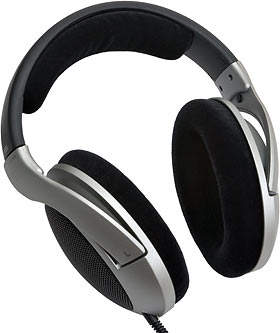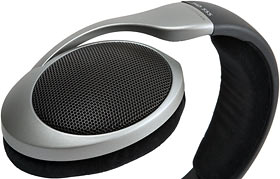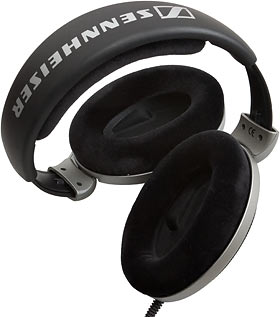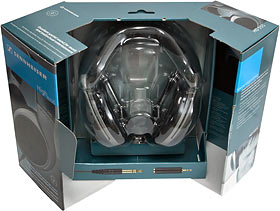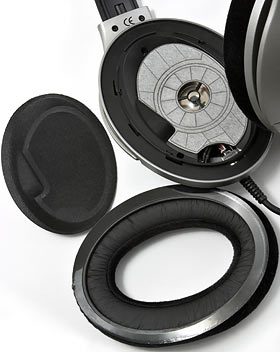
Sennheiser HD 555 headphones
Review date: 29 September 2004.Last modified 03-Dec-2011.
I've mentioned Sennheiser's HD 555 headphones in passing on previous occasions, but I've only now gotten around to reviewing them. That's because only now has it become possible to actually buy the darn things again.
A Sennheiser factory caught fire, y'see, and the result was something of a worldwide drought of some Sennheiser models, including the 555s.
But now the stores here in Australia have stock again, which I suppose means 555s must be back all over the world by now, seeing as how Ireland and Germany are, uh, way over there somewhere, from our Antipodean point of view.
(I'm not clear on the details. I think you turn left at Narnia or something.)
I'm glad to see the HD 555s back, because they're not just any old headphones. They are, actually, pretty much precisely the headphones that a lot of people are looking for. They do almost everything exactly right.
I'm sorry if this totally spoils the review for you.
What they are
The HD 555s are open, circumaural, full-sized headphones. That means they let outside noise in and inside noise out (so they're not suitable for use in noisy environments, or near people who don't want to hear a tinnier version of what you're hearing), and they're comfortable even if you wear them for a long time (because their ear cushions sit around your ears, not on top of them), and you'll look a bit stupid if you wear them in public (because they may be all sleek and sci-fi looking, but they're hardly small enough to hide under most hairstyles).
If you're looking for slick full-sized 'phones, the 555s fit the bill. Surprisingly strong one-sided headband hinge connection? Check. Single-sided cable input? Check. Shiny black metal grilles, not many corners, tasteful silver-grey highlight plastic? Check, check, check.
The silver "Sennheiser" logo on the headband's a bit big, if you ask me, but if you often find yourself having trouble remembering who made your consumer electronic goods, I'm sure you'll find that helpful.
More practically, these headphones have a high quality ratchetty size adjustment that should let them fit heads from somewhat-small to downright-enormous. They have a quite ample ten foot non-curly cord. And their headband is tough yet twistable...
...which should make the headphones more resilient, and also makes it very easy to pull one ear-cup off your ear without budging the other one.
Like a lot of full-sized headphones these days, the HD 555s are quite light; Sennheiser quote a weight of 260 grams (9.2 oz) without the cable. I think that's actually a bit of an overstatement.
The HD 555 earpieces are quite distinctive. The drivers inside are angled backwards - the better to shoot sound straight into your ears - and there's a funny little wedge-shaped "surround reflector for an extremely spatial sound reproduction", too.
This design apparently has something to do with Sennheiser's "Eargonomic acoustic refinement" system. Well, that's what their German site calls it; their US branch doesn't have the courage to overrule their spellchecker. Ah, marketing.
The 555 cushions are covered with finest black velvety stuff, which is good, but they're a bit on the firm side. Together with above-average pressure from the headband, these headphones end up among the most comfortable I've worn, but not very near the top of the list.
I'm happy wearing them for hours on end, though; I'm just happier wearing my softer and squishier HD 590s.
This unnecessarily arty image serves to convey the fact that the HD 555 cable terminates in the quarter inch plug that's used by full-size hi-fi gear, not the eighth inch plug used by portables and computers. All full-sized headphones used to have the bigger plug, but most manufacturers have gone with the smaller one these days.
You get an adapter with the 555s, of course, but a quarter inch plug adapted down to eighth inch is cumbersome. You end up with the thick end of three inches of rigid plug body hanging off the poor little eighth inch connector, with the weight of the cable on the end of that considerable lever. It doesn't take much of a tug on a setup like that to wreck the plug, the socket or both.
For this reason, HeadRoom recommend eighth-inch-users buy this floppy Grado adapter to replace the solid Sennheiser one. At $US14.95, that may be Grado's cheapest product (though their entry level headphones are surprisingly cheap), and equivalent items are a bit hard to find so you might as well buy it.
Anyone handy with a soldering iron can, of course, knock up a functionally identical product (provided you're not too worried about Martians) for a couple of bucks.
Oh, and there's this. Sennheiser's been moving to economical clamshell packaging for a lot of their headphones lately, but the HD 555s come in an imposing gatefold box that looks as if it ought to have a Star Wars DVD set in it, or something.
What they cost
The HD 555s are mid-priced headphones, by audiophile standards at least. They can
be yours for $US149.95 ex shipping from
HeadRoom (list
price is $US170). And here in Australia, Aus
PC Market are selling them for $AU231 only $AU187 including
delivery anywhere in the country (Aussie shoppers can
click
here to order).
There are some weird pricing shenanigans going on for some Sennheiser products locally, but the 555s have escaped that noose. Their delivery-included Australian price is only around 10% higher than their US price, once you run the currency conversion. There is, therefore, no reason for Australian buyers to even consider ordering these 'phones from overseas, unless local stocks dry up again.
Listening
The HD 555s aren't the best headphones I've ever heard - that accolade falls to some Beyerdynamic heavyweights that cost more than twice as much locally - but they're darn good. Sennheiser's claims about very low colouration and extended frequency response sound true to me. The 555s have clear but not overemphasised treble, no bad behaviour in the midrange, and kickin' bass for those moments when it matters, without so much thump that it swamps everything else.
I trundled through my usual classical, jazz, rock and electronic test tracks, and then made with the random play. The 555s did a good job by anyone's standards on everything, and a great job when you consider their not-so-scary price tag.
I still prefer the sound of my HD 590s, which don't get a lot of love from the headphone cognoscenti but have a wider soundstage (weird surround reflectors or no weird surround reflectors) and more treble clarity, I think, than the 555s. The 590s cost more, of course, so you'd want 'em to sound a bit better.
And, as I said, the 555s aren't quite as comfortable as the 590s.
But if someone took my 590s away and forced me to use the 555s, I'd be perfectly happy.
The HeadRoom test results for the 555s show a well-behaved frequency response plot with solid results down to 30Hz (not quite the 15Hz Sennheiser glibly claim, but more than enough for pretty much every purpose), a slightly mountainous impedance plot that shouldn't cause any problems, and the crummy isolation common to all open headphones.
For $US150 or the rough equivalent in Australian pesos, these are some rather pretty pictures.
Niggling numbers
The 555s I reviewed have a nominal impedance of 120 ohms. At some point in the six years between when I first wrote this review and when I'm updating it in mid-2010, though, Sennheiser changed this to a nominal impedance of 50 ohms.
All things being equal, more impedance means less volume for a given volume knob setting, and the amplifiers in most portable audio devices (and a disturbing number of non-portable ones) can't manage a whole lot of clean output voltage. Even if background noise (which'll come straight through open headphones) and the goofiness of big headphones with a little MP3 player aren't an issue for you, therefore, the original 120-ohm 555s may not quite cut it without an outboard amplifier of one kind or another - though 120-ohm impedance isn't that high, and some of the higher-quality portable players can pump out decent voltage.
Just the same, though, low-impedance (32 ohms, usually) or very-high-efficiency (more noise per milliwatt) headphones are better for portable use, and higher efficiency is, all things being equal, a good thing in general.
At a glance, the original 120-ohm 555s seemed to be big efficiency winners - the Technical Data section of Sennheiser's HD 555 page said they had got 103dB efficiency. That's very good compared with the 97dB-ish figures scored by various other then-current headphones, like the HD 590s and the higher-end HD 600s. 103dB is twice as much energy as 97dB, and a very worthwhile difference.
Those 97dB headphones, though, achieve that output volume from a standard one-milliwatt input, the voltage and current that make it up varying with the headphones' impedance. 32-ohm headphones need about 0.18 volts, which'll push about 5.6 milliamps through them, to manage one milliwatt. 600-ohm 'phones need about 0.77V, to push 1.3 milliamps.
The HD 555s were, in Sennheiser's specs, for some reason being fed a one-volt input. At a nominal 120 ohms, that means a power level of about 8.3 milliwatts. Twice the sound energy from eight times the input power is hardly a surprising result, and suggests that those HD 555s actually had somewhat below average efficiency; I noticed my HD 590s sounded a little louder when I swapped them with the 555s. The difference wasn't large, though.
The revised 50-ohm HD 555s still have a 1V efficiency number, but it's up to an impressive 112dB. This adds up to genuinely higher efficiency than many other full-sized headphones, and along with the lower impedance means they should work well with a lot more devices than the 120-ohm originals. I haven't tested the 50-ohm version myself, though.
Giblets
Like all quality headphones, the HD 555s are serviceable. You can replace the ear cushions and the cable yourself, and handier individuals should be able to swap out the driver elements as well.
The 555 earpieces are quite easy to take apart, if you pay attention to the melodically named HD 5x5 Kabelmontage_eng.pdf...
...and here are the parts. Well, almost all of the parts; there was also a little cube of foam that I probably should have included in this picture, because then I might have remembered to put it back in the first time I reassembled the thing.
Anyway, this level of dismantlement is as far as you have to go if you need to replace the 555s' cable. More expensive Sennheisers have one or another kind of external plug-in cable, which is very easy to replace and also protects the headphones from damage if you accidentally pull the cable taut, but this is an OK compromise between convenience and expense.
The sealed HD 280s have a similar cable connection, but you need a screwdriver to take them apart and some patience to get the ear cushions back on afterwards, thanks largely to the demands of the sealed design. The HD 555s just clip together, and not in the frighteningly fragile way we old school gadget hackers remember.
Overall
Gee, I'm glad you can buy these things again.
Because, you know, you probably should. They're really good-sounding, comfortable cans that don't cost a ton of money.
(They were $AU231 here in Australia when I first put this review up - they're $AU187 delivered now, which is a downright bargain.)
Yes, you can pay twice as much and get something detectably better - but not twice as good. And the 555s are tough enough that you can take 'em to LAN parties, throw 'em in your office filing cabinet at quitting time, and similarly treat them with only moderate respect, without worrying. And the current 50-ohm version should even work well with most portable players.
I'd like to see an external cable socket on them, and I'd like to see an eighth-inch plug on the cable (or a wired adapter rather than the plug-extender type). But this is nitpicking.
For this money, I doubt you can buy a better headphone anywhere. Highly recommended.
Sennheiser's page for the HD 555s
Buy them!
Readers from Australia or New Zealand can purchase the HD 555s from Aus PC Market.
Click
here!
